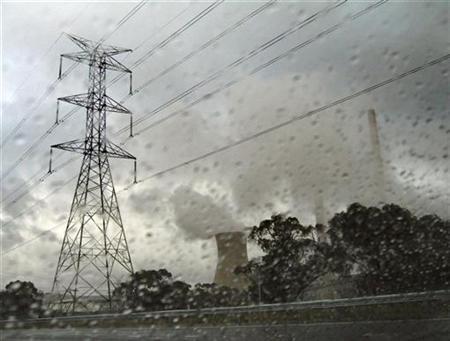Cyclone May Be Tipping Point In Australia Climate Policy Debate
Date: 03-Feb-11
Country: AUSTRALIA
Author: David Fogarty

Raindrops are seen on a car windscreen as mist obscures power-lines
and chimneys from the coal-burning Mount Piper Power station,
located in the Central West region of New South Wales, around 150
kilometres (93 miles) west of Sydney, May 19, 2007.
Photo: Reuters/David Gray
Australia has endured two of its deadliest summers on record, blamed in part on global warming, but record fires, floods and cyclones have not persuaded it to take strong action on climate change.
But some experts hope that Wednesday's arrival of giant Cyclone Yasi on the coast of Queensland, already hit by massive floods last month, will help bring more of a sense of urgency to the political debate over climate policy.
Environmentalists have despaired that one of the world's highest per-capita carbon polluters will ever embrace the need to cut emissions, given that most politicians and voters have not made a strong connection with disasters and manmade global warming.
They say they are baffled why weather-beaten Australians are not pushing for stronger policies to cut carbon emissions from power stations, mines, transport and refineries.
"If you want a picture of what a hostile and costly environment looks like, we've had it in spades over the past couple of years," said John Connor, CEO of the Climate Institute think tank.
"Most of our politicians and most of our major media outlets have been extremely hesitant in drawing any connection," he told Reuters, referring to a climate change link.
"It's a toxic blend of denial, media management and sheer lack of leadership," he added.
The government has pledged to put a price on carbon emissions this year as a key pillar of its climate change fight after failing to get sweeping emissions trading legislation through parliament and nearly losing elections in 2010.
At the heart of the issue is that emissions trading would affect all sectors of the economy through higher fuel and power prices. The government has rowed back by reviewing the issue, without saying how carbon emissions will be priced.
"It's right to price carbon, the most economically efficient way of reducing pollution," Prime Minister Julia Gillard said in a speech on Tuesday.
A few days earlier in a radio interview, Gillard said she recognized that climate change was real but did not want to connect it with the recent floods.
"I don't think you can look at one, a bit of the weather and say that equals climate change. I don't think it's as simple as that."
Australia has looked at trying to price carbon for over a decade but has faced fiercely opposing views, with lobbying from miners fearing higher costs and opposition scare campaigns over higher taxes and job losses.
Connor thought the recent floods and Cyclone Yasi could be a game changer by putting more pressure on the government to beef up its climate policies.
"People may look afresh at this once we're through managing the emergency and added up the costs," he said.
The Australian Greens, which give key support to the ruling Labor party, believe Australians would be willing to pay for steps to fight greenhouse gas emissions and want an initial carbon price followed by an emissions trading scheme.
IT'S NOT ALL CLIMATE CHANGE
Veteran climate scientist Neville Nicholls said a possible reason for lack of public action was the tendency for some people to try to link all Australian extreme weather and climate events to climate change.
"When a climate extreme of the opposite variety comes along, this makes it easy for those who want pretend that it is all just natural climate variability to paint all climate science as 'alarmist'," said Nicholls of Monash University in Melbourne.
Since 2006, Australia has suffered a string of disasters that have costs hundreds of lives, caused losses in the billions disrupted the crucial agriculture and mining sectors.
In March 2006, Cyclone Larry tore through the northern Queensland town of Innisfail, causing an estimated A$1.5 billion in damage to the area.
A combination of drought and a record-breaking heatwave February 2009 triggered the nation's deadliest fires around the southern city of Melbourne that killed 173 people and A$1 billion in insurance losses. Severe storms in Perth and Melbourne last year also caused losses of about A$1 billion.
Floods in Queensland, New South Wales and Victoria since December have killed 35 people and become the nation's costliest natural disaster, swamping 30,000 homes and crippling Queensland's coal industry.
Australians were already paying for weather extremes through food price inflation and higher insurance premiums.
"The insurance industry knows the damage bill from these events is already on the rise," said Matthew England of the Climate Change Research Center at the University of New South Wales in Sydney.
"So we can't just continue to mop-up without thinking about how fossil fuel emissions are changing our climate," he added
![]()
© Thomson Reuters 2010 All rights reserved